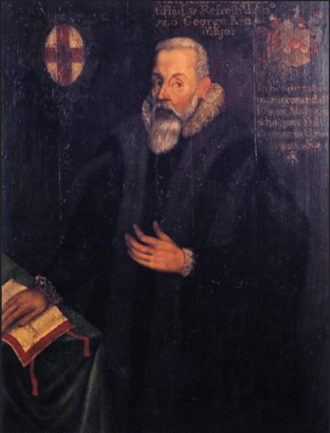Thomas Sutton facts for kids

Thomas Sutton (born 1532 – died 12 December 1611) was an important English civil servant and businessman. He was born in Knaith, Lincolnshire. Today, he is best known for starting the London Charterhouse and Charterhouse School.
Contents
Thomas Sutton's Life Story
Thomas Sutton was the son of an official in the city of Lincoln. He went to school at Eton College and then studied at St John's College, Cambridge.
Early Career and Wealth
For a big part of his life, Thomas Sutton had an important job called Master of the Ordnance in the North. This meant he was in charge of military supplies and building defenses in northern England.
He also made a lot of money from coal. In 1578, he got the right to use land in Whickham and Gateshead, near Newcastle. This land had coal mines, and he earned a lot from them. Five years later, he sold this right, which made him even richer.
In 1582, he married Elizabeth Dudley. She was a widow and related to powerful families like the Earls of Warwick and Leicester. This marriage greatly increased his yearly income.
Thomas Sutton had strong connections to the Dudley family. Early in his career, he worked for the Earl of Warwick. This Earl later helped him get his job as Master of Ordnance in 1569. The Earl of Leicester, who was a favorite of Queen Elizabeth I, also helped Sutton get the coal mine land.
Buying Property
Sutton bought a large house called Howard House. This house was built on the site of an old monastery in London. Even though the monastery was closed by King Henry VIII, parts of it were still standing.
He also bought other large areas of land. One was the manor of Castle Camps in Cambridgeshire, which had been owned by the de Vere family for over 500 years. He also owned land near Saffron Walden in Essex.
Helping England
In 1588, Thomas Sutton gave £100 to help defend England against the Spanish Armada. This was a huge fleet of ships sent by Spain to invade England. It's thought that he owned a ship called The Sutton. This ship captured a Spanish vessel and its valuable cargo, worth about £20,000.
Becoming a Moneylender
Later in his life, Sutton became one of the main moneylenders in England. He lent money to many different people, from farmers to important politicians and businesspeople. These included Lord Burghley and Sir Edward Coke. He usually charged a standard interest rate of ten percent a year.

Thomas Sutton died on 12 December 1611 at his home in Homerton. He was considered one of the richest people in England at that time. His wealth was estimated to be worth over £50,000, mostly from money owed to him. Because he was so rich, people called him "Croesus" and "Riche Sutton."
Thomas Sutton's Legacy
Thomas Sutton left a large part of his money to create a special place. This place was for 80 poor gentlemen and a school for 40 boys. It was built on the land where his house stood, near Charterhouse Square in London.
This institution was first called the Hospital of King James in Charterhouse. Later, it became known as Sutton's Hospital in Charterhouse. The part for the gentlemen (called an almshouse) is still on the original site today. The school, now called Charterhouse School, moved to Godalming, Surrey, in 1872.
The buildings in London were badly damaged during the Second World War by bombs. However, they were rebuilt and fixed in the 1950s.
The school still uses Thomas Sutton's personal coat of arms. It shows three crescents on a red chevron between three red rings on a gold background.
See also
- Case of Sutton's Hospital
Images for kids





